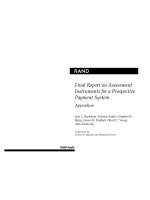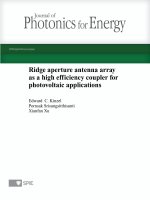GAN ON SI(100) NANOSTRUCTURES FOR OPTOELECTRONICS APPLICATIONS
Bạn đang xem bản rút gọn của tài liệu. Xem và tải ngay bản đầy đủ của tài liệu tại đây (19.58 MB, 241 trang )
GaN-on-Si(100) NANOSTRUCTURES FOR
OPTOELECTRONICS APPLICATIONS
ANSAH-ANTWI KWADWO KONADU
NATIONAL UNIVERSITY OF SINGAPORE
2015
!
ii!
GaN-on-Si(100) NANOSTRUCTURES FOR
OPTOELECTRONICS APPLICATIONS
ANSAH-ANTWI KWADWO KONADU
(B.Eng.(1
st
Hons.), University of Ghana)
A THESIS SUBMITTED
FOR THE DEGREE OF DOCTORATE IN PHILOSOPY
DEPARTMENT OF ELECTRICAL AND COMPUTER
ENGINEERING
NATIONAL UNIVERSITY OF SINGAPORE
2015
!
iii!
DECLARATION
I hereby declare that the thesis is my original work and it has been written in
its entity. I have duly acknowledged all the sources of information which have
been used in the thesis.
This thesis has also not been submitted for any degree in any university
previously.
Ansah-Antwi Kwadwo Konadu
20 January 2015
!
iv!
Acknowledgements
!
May I take this opportunity to express my appreciation to my Heavenly Father
who has kept me alive and made every provision possible for me throughout
all these years. I am indeed grateful to the Agency of A*STAR Graduate
Academy (A*GA) for the PhD fellowship. To all the staff of the A*GA
secretariat I wish to extend a warm and hearty appreciation for your support in
various capacities.
To the best supervisor in the world in the person of Prof Chua Soo Jin of the
Department of Electrical and Computer Engineering, NUS, I wish to say a big
thank you for all the years of nurturing and mentoring. To me you were more
than an advisor or mentor, your experience with handling students of different
cultures cannot go unnoticed. Sometimes in life, we meet people who are
simply nothing more than God-sent, and this is what you have been to me. To
Dr. Soh Chew Beng of Singapore Institute of Technology, you continued to be
of immense support even after seized being my official co-supervisor. My
heart goes out to you for always stepping out and going the extra miles to see
to it that I was comfortable and making progress with my research work. To
Dr. Liu Hongfei, my diligent co-supervisor, you were indeed the most
inspirational person that I might have encountered in the field of research. I
have benefited immeasurably from your keen sense of analytical reasoning.
To all my colleagues in the Centre for Optoelectronics laboratory especially
Ian Seetoh, Jian Wei, Zhang Li, Tang Jie, Liu Yi and Chengguo, your
companionship and cooperation meant a lot to me and I will always remember
the good lunch and Chinese New Year celebrations we had at Prof Chua’s
residence. My sincere appreciation also goes to Dr. Yang Ping and Dr. Sascha
Heussler of Singapore Synchrotron Light Source (SSLS).
And lastly to the staff of the Institute of Materials Research and Engineering
who made my stay worthwhile both professionally and socially, especially
Eric Xiaosong, Vincent Lim, Neo Kiam, David Paramella, Jarrett Dummond
and Hannah Lim, I salute all of you.
Most of all, I will like to thank my beloved family and loves who have been
with me through both the happy and sad moments. I appreciate all your
prayers and encouragement.
!
v!
Table of Contents
Acknowledgements iv
Summary ix
List of Figures xi
List of Tables xxviii
CHAPTER ONE: Introduction 1
1 Summary 1
1.1 Properties of AlN, InN and GaN materials 3
1.1.1 Crystal structure of III nitride semiconductors 3
1.1.2 Electronic and Optical properties of III-nitrides 5
1.2 Si as a semiconducting material 7
1.2.1 Physical properties of Si 7
1.2.2 Pitfalls of Si as a material for optoelectronics 9
1.3 The battle for the optoelectronic space 11
1.3.1 Integration of GaN and silicon 11
1.4 Objectives 13
1.5 Motivation 14
1.6 Scope of thesis 15
CHAPTER TWO: Overview of research work on GaN-on-Si(100) 17
2.1 Introduction 17
2.1.1 Bulk GaN substrate developments 19
2.1.2 Ga-melt based bulk GaN 19
2.1.3 Na flux method 20
2.1.4 Hydride Vapor Phase Epitaxy (HVPE) 22
2.1.5 Ammonothermal method 23
!
vi!
2.2 Heteroepitaxy of GaN-on-Si 25
2.3. Challenges with the heteroepitaxy of GaN-on-Si 27
2.3.1 Lattice mismatch and surface atomic symmetry 27
2.3.2. Coefficient of thermal expansion mismatch 31
2.3.3 Lack of semi-insulating Si substrates 33
2.3.4 Diffusion of Si into GaN thin film 34
2.3.5 Absorption of light emitted from the InGaN/GaN active layer by the
Si substrate 36
2.4. Approaches to solve the challenges of the growth of GaN on Si 36
2.4.1. Buffer layer technology 37
2.4.2 Use of Miscut substrate for the growth of high quality GaN epilayer
39
2.4.3 Transfer of GaN based devices unto a pseudo/virtual-substrate 43
2.4.4 Growth of GaN epilayer on patterned foreign substrates 44
2.4.5 Growth of GaN on {111} sidewall of Si(100) substrate 46
2.5 Non-polar and Semi-polar GaN 52
CHAPTER THREE: Equipment and Materials 54
3 Introduction 54
3.1 UV Mask aligner 54
3.2 Reactive Ion Etching System (RIE) 55
3.3 Plasma enhanced chemical vapor deposition (PECVD) 57
3.4 Metalorganic chemical vapor deposition (MOCVD) 58
3.5 X-ray diffraction (XRD) 65
3.6 Scanning electron micrograph 67
3.7 Transmission electron microscope 68
3.8 Atomic force microscope (AFM) 69
3.9 Raman scattering and Photoluminescence spectroscopy 70
!
vii!
CHAPTER FOUR: Effect of substrate patterning/modification on the quality
of GaN epilayer grown on Si(100) substrate by MOCVD 72
4.1 Summary 72
4.1.1 Introduction 72
4.1.2 Surface patterning of Si(100) substrate by UV lithography 74
4.1.3 Anisotropic etching of Si(100) substrate in an aqueous potassium
hydroxide (KOH) solution 76
4.2 MOCVD heteroepitaxial growth process of III-nitride films 80
4.2.1 Surface morphology of the as-grown GaN layer 83
4.2.2 Crystal structure characterization of as-grown GaN epilayer grown
on {111} facets exposed on Si(100) substrate 90
4.2.3 Optical characterization of as-grown GaN epilayer grown on the
{111} facets exposed on Si(100) substrate 96
4.3 Surface passivation of the Si(100) substrate with dielectric films 114
4.4 Increased GaN growth selectivity with Titanium nitride (TiN) film as
passivation layer 115
4.4. Conclusions 118
CHAPTER FIVE: Crystallographically Tilted and Partially Strain Relaxed
GaN Grown on Inclined {111} Facets etched on Si(100) Substrate 121
5.1 Summary 121
5.1.1 Introduction 122
5.1.2 Template preparation and patterning fabrication 122
5.1.3. Surface analysis of the Si{111} facet exposed on the Si(100)
substrate 125
5.1.4 MOCVD Growth of III-nitride films on patterned Si(100) and
conventional Si(111) substrates 127
!
viii!
5.2 Evidence of the crystallographic tilt by reciprocal space mapping (RSM)
and HRXRD study of as-grown GaN film 132
5.3 Optical property evaluation by µ-PL and µ-Raman spectroscopy 137
5.4 Dislocation bending away from the GaN(10-11) plane 143
5.5 Conclusions 146
CHAPTER SIX: Surface step assisted threading dislocation density reduction
in GaN epilayer grown on V-grooved on-axis Si(100) substrate 148
6 Summary 148
6.1 Introduction 149
6.1.1 Template fabrication and materials’ growth 151
6.1.2 Surface morphology of etched Si(100) surface 155
6.1.3 HRXRD study of the crystal quality and extended defect density of
GaN epilayer 158
6.1.4 Evaluation of optical quality of as-grown GaN epilayer by PL
spectroscopy and Raman scattering 162
6.2 Determination of relationship epitaxial tilt and substrate offset 166
6.2.1 Vicinal surface assisted dislocation reduction mechanism in GaN
epilayer 168
6.3 Facet controlled III-nitride epilayer grown on an inclined Si{111} plane
173
6.4 Conclusions 182
CHAPTER SEVEN: Conclusions and Future Perspective 184
7.0 Conclusions 184
7.1 Future Perspective 189
Bibliography 191
Publications 209
Conference Presentations 211
Awards for thesis work 213
!
ix!
Summary
In this thesis, approaches to grow high quality GaN-based nanostructures on
Si(100) substrate were developed. Due to the large coefficient of thermal
expansion (CTE) mismatch of 56% between the Si substrate and the GaN
layer, the use of surface-patterned/modified Si substrates help to reduce the
cracking of the as-grown GaN epilayer. The III-nitride [Ga(Al, In)N) films
were deposited on the Si(111) sidewalls that were exposed on the Si(100)
substrate after potassium hydroxide (KOH) anisotropic etching.
Triangle/hexagon array of the anisotropically exposed Si(111) facets side-
walled holes was found to be critical to obtain coalescence of the GaN
epilayer after it had overgrown above the etched holes.
In another experiment, the quality of the GaN epilayer grown on the exposed
Si(111) facets of the V-shaped trenches on the Si(100) substrate was
contrasted with the GaN epilayer grown on the planar Si(111) substrate.
Higher surface quality of the exposed Si(111) facets were obtained for cases
where the trenches were aligned either perpendicularly or parallely to the
Si[011] crystallographic direction. Vicinal surface induced steps on the
exposed Si(111) facets resulted in crystallographic tilt between the (0002)
plane of the III-nitride epilayers and the Si(111) plane. This crystallographic
tilt was found to be related to the improvement of the crystal quality and the
enhancement of about 5 times higher internal quantum efficiency (IQE) of the
GaN epilayer grown on the exposed Si(111) sidewalls of the V-groove
trenches compared to the GaN epilayer grown on the planar Si(111) substrate.
!
x!
To further study the effects of surface steps on the properties of the as-grown
GaN epilayer, the height of the steps was engineered by misaligning the 3 µm
wide trenches at predetermined angles α, (i.e. 2, 4 and 6
o
) away from the
Si[011] crystallographic direction. The misaligned trenches exhibited steps
with different heights on the exposed Si(111) facets after anisotropic etching
in KOH solution. 50 nm thick AlN buffer layer was deposited on the slanted
Si(111) facet with AlGaN as an interlayer. The growth structure was
terminated with 500 nm – 1 µm thick GaN epilayer. It was found that GaN
epilayer grown on the V-grooves aligned at 6° away from the Si[011]
direction had the lowest threading dislocations (TDs) density of about 2.1 x
10
8
cm
-2
which was about two order of magnitude lower than the TDD in other
GaN samples with different misalignment angles. The reduction in the TDs
was achieved through the bending of the dislocations away from the GaN
epilayer by the 3D islands of the AlN buffer layer. From the above
observation, GaN/InGaN(10-11) rod with a triangular cross section was grown
lying on a single Si(111) sidewall of the etched V-groove. The other Si(111)
sidewall was completely isolated from the GaN deposition. The deposition of
the GaN/InGaN triangular rod on the single sidewall of the V-grooves was
achieved by aligning the trench’s longitudinal axis perpendicularly to the flow
direction of the precursor gas within the boundary layer over the substrate.
This method promises to be cheaper and a reproducible route to prepare GaN
epilayer on the single facet of the V-groove trench [for a turbo disk MOCVD
system] with crystal quality compared to the conventional method via surface
passivation.
!
xi!
List of Figures
Figure 1-1. Historical timeline of the development and milestones of light
emitting diodes (LEDs). 2
Figure 1-2. Comparison between the wurtzite and zincblende strutures. a) and
b) 3D view of the ZB and WZ , respectively and c) and d) the view of the ZB
along the (111) and WZ along the (0001) direction, respectively. 4
Figure 1-3 Illustration of the relationship between in-plane lattice constant and
bandgap energy for SiC, GaN and Si. 5
Figure 1-4 Comparison between the energy bandgap diagram a) wurtzite and
b) zincblende GaN material. 6
Figure 1-5 a) 3D isometric view of Si (diamond) structure and b) 2D plan
view of Si indicating the positioning of atoms within different sublattices. 7
Figure 1-6 A photo of Si boule sliced and polished Si wafer at different
diameters. 8
Figure 1-7 Sketches of the three most common planes of Si crystal ({100},
{110} and {111}) showing the arrangement of atoms and their respective
atomic packing densities. Si(100) has the lowest atomic packing density and
most susceptible to chemical attack. 9
Figure 1-8 Illustration of the difference between the bandgap structure of a
typical III-nitride semiconductor and Si. Phonon assisted transitions are
observed for the Si indirect bandgap. 10
Figure 1-9 Forecast of the penetration and market share of GaN-on-Si LEDs.
12
!
xii!
Figure 2-1. Deployment of GaN based devices for various applications. 17
Figure 2-2 Lighting accounts for 30% of the electricity consumed by U.S.
buildings. 18
Figure 2-3 Scanning electron micrograph of GaN single crystal obtained by
slow cooling of the stoichiometric melt at 6.8 GPa. 19
Figure 2-4 A schematic illustration of the growth apparatus to grow bulk GaN
by the Na flux method. 21
Figure 2-5 A 2 inch GaN crystal grown by apparatus in Figure 2-3 a) as grown
b) after polishing as grown crystal. . 21
Figure 2-6 Schematic representation of the fabrication of freestanding GaN
wafer by HVPE. 23
Figure 2-7 Schematic illustration of the ammothermal process. 24
Figure 2-8 Comparison of HVPE with ammonothermal method a)
Cathodoluminescence of HVPE GaN (left panel) and ammonothermal GaN
(right panel) and b) Picture of 2-inch GaN grown by MOCVD on sapphire
substrate. 25
Figure 2-9 Illustration of heteroepitaxy growth of epitaxial film on a case 1)
substrate with shorter in-plane lattice constant, case 2) substrate with wider in-
plane lattice constant compared to the in-plane lattice constant of the epilayer.
Below the critical epilayer thickness, the epitaxial film is pseudomorphic to
the substrate. Beyond the critical thickness, misfit dislocations are generated.
28
Figure 2-10 Comparison of the plane view of Si(111), GaN(0001) and Si(100).
29
!
xiii!
Figure 2-11 Schematic illustration of the overlaying of GaN(0001) on Si(111)
and Si(100). For GaN-on-Si(100), the co-existence of two GaN doamins is
observed. Adopted from Ref. 30
Figure 2-12 SEM of a) AlN and b)AlN/GaN grown on nominal Si(100)
substrate and c) transmission electron micrograph (TEM) showing the
interface of Si and AlN crystals . 31
Figure 2-13 Linear thermal expansion coefficient of III-V materials, SiGe, Ge,
Si, SiC and sapphire as a function of temperature. 32
Figure 2-14 Schematic illustration of III-nitride epi-film on Si substrate at a)
high growth temperature (i.e. 1000
o
C) and b) room temperature after cooling
down from the growth temperatures. 32
Figure 2-15 SEM plan view showing crack propagation on the surface of thick
GaN grown on Si(111) substrate. The cracks travel along specific
crystallographic directions. 33
Figure 2-16 Different appearances of meltback etching of Si. Normaski
microscope image (a-c): A particle is the origin of cracks and meltback
etching (a) visible when too-high tensile stress occurs. Image (b) shows crack,
which occurred during growth and acts as origin of meltback etching. Too-thin
Al causes meltback etching, as in the image (c). Scanning electron microscopy
images (d and e) show an extreme form of meltback etching an also the origin
of the name, deep hollows etched in the Si substrate (d). Here the nominal
layer thickness was only around 3. A typical Ginko leaf (f) appearance is
shown in image (e). Typically, such meltback etching reaction propagates
along the Si/AlN/GaN. 35
!
xiv!
Figure 2-17 Schematic illustration of light emited from the active layer of an
InGaN LED grown on Si substrate. Light that enters the Si substrate is
absorbed and not reflected backward to be extracted through the top surface.
36
Figure 2-18 Plan view SEM of GaN grown on a) LT-AlN buffer layer on
Si(100). The image is taken with an inclination of 43
o
and b) AlN/GaN
superlattice buffer layer on Si(001). 39
Figure 2-19 Schematic of ball-and-stick model of the steps on a Si(100)
surface. The step dimers of the top-most terrace bonds to a dimer of the
adjacent terrace or step. 40
Figure 2-20 HRTEM images of the interface area; a) between nominal Si(001)
substrate and two domain AlN epilayer in the domain-boundary-free area and
b) between 5
o
-tilted toward [110]Si(001) substrate and single-domain AlN
epilayer (double-stepped Si surface). (c,d) Schematic view of the possible
atomic arrangement at the interface between the epilayer and the substrate; c)
for a two-domain AlN film grown on the nominal, single-stepped Si(001)
surface and d) for a single-domain AlN film grown on the double-stepped
Si(001) surface. 41
Figure 2-21 AFM imaging shows the surface morphology of the GaN layers
on Si(001). With increasing off-orientation angle the surface becomes
smoother and due to the increasing tensile stress in the layer some cracks
occur after cooling. 42
Figure 2-22 Plan view SEM of a) AlGaN and b) AlGaN/GaN grown on
Si(100) substrate with 6
o
substrate offcut. 42
!
xv!
Figure 2-23 a) Schematic view of GaN based LED structure built on Si(001)
substrate and b) Illustration of the light from a InGaN LED built on Si(001).
43
Figure 2-24 Schematic of the steps involved in the growth of AlGaN/GaN
epilayer on Si(100) via wafer lift off and epilayer transfer. The growth is
initiated on Si(111) substrate to obtain high quality AlGaN/GaN material and
the transferred onto a Si(001) substrate by lift off. 43
Figure 2-25 a) Cross-sectional SEM image of Si-GaN-Si pseudo-substrate and
b) Plan view SEM image of the fabricated transistor and c) Cross-sectional
illustration of Si p-MOSFETs and GaN HEMTs. 44
Figure 2-26 SEM image of GaN epilayer grown on patterned Si(111)
substrate. Cracks are isolated from the device structures due to the micro
patterning of the substrate. 45
Figure 2-27 SEM image of (a) micro-patterned sapphire substrate (MPSS) and
(b) nano-patterned sapphire substrate (NPSS), AFM image of GaN grown on
(c) planar sapphire and d) patterned sapphire substrate (PSS) and e) light
output of InGaN LEDs grown on different sapphire substrates. 46
Figure 2-28 Schematic illustration of the substrate surface modification
process. 48
Figure 2-29 Stereographic projection of Si(001) surface. 49
Figure 2-30 Triangular stripe of GaN grown on {111} sidewall exposed on
Si(100) substrate. 50
Figure 2- 31 Tilted cross-section SEM image of GaN grown on Si(100)
substrate with offcut a) lower than 7
o
and b) of ~7
o
. c) and d) Atomic force
microscope of a) and b) respectively. 51
!
xvi!
Figure 2- 32 Low temperature (LT) time resolved photoluminescence (TRPL)
of {10-11} InGaN/GaN MQW and {0001} InGaN/GaN MQW. 51
Figure 2-33 Schematic illustration of a) the polar c-plane (0001), b) the
nonpolar a-plane (11-20), c) the non-polar m-plane (10-10) and d-f) the
semipolar planes (10-1-3), (10-1-1), and (11-22), respectively. 52
Figure 2-34 Summary of the research timeline of nonpolar and semipolar GaN
material quality: a) the density of BSFs and b) threading dislocations. The
gray bar in b) indicates the typical range of threading dislocation desnity
density in heteroepitaxial c-plane GaN film. 53
Figure 3-1. Photograph of Karl Suss MA8/BA 6 located in the cleanroom of
Institute of Materials Research and Engineering (IMRE). 55
Figure 3-2 Simplified illustration of processes occurring in reactive ion
etching (RIE). 56
Figure 3-3 Photograph of Oxford II reactive ion etching system. 57
Figure 3-4 Photograph of Nextral D200 manual PECVD system for deposition
of SiO
2
and SiN
x
thin films. 58
Figure 3-5. Various thermodynamic processes that occur inside an MOCVD
growth chamber. 59
Figure 3-6. a) The 3-D model MOCVD reactor conditions show the sharp flow
transition required for uniform film growth, and b) smoke flow patterns in
rotating disk system. Courtesy of Sandia National Laboratory. 59
Figure 3-7. Photo of D180 MOCVD system in Institute of Materials Research
and Engineering (IMRE), Singapore. 60
!
xvii!
Figure 3-8. a) Photo of the growth and load lock chamber showing the
pyrometer and other elements connected to the growth and b) schematic of the
growth chamber. 61
Figure 3-9. Left) Photo of the temperature controller water bath used for
regulating the temperature of the MO and right) schematic illustration of the
bubbler and MO container. 62
Figure 3-10. Left and middle) Photo and schematic illustration of light source
unit and lens assembly and right) schematic illustration of optical cable for
collecting information from the epimetric film measurement unit. 63
Figure 3-11. Left) Schematic illustration that shows the measurement of GaN
film thickness and right) sketch of the typical reflectance spectrum. 63
Figure 3-12. A sketch of trimethyl gallium [aluminum or indium], (CH
3
)
3
-
Ga(Al, In) molecule. 64
Figure 3-13. Schematic representation of the diffraction of X-ray from atomic
planes of a crystalline material for illustrating Bragg’s law. 65
Figure 3-14. Photo of left) Oxford built X-ray diffractometer at Singapore
Synchrotron Light Source (SSLS) and right) PANalytical X’Pert X-ray
diffractometer. 66
Figure 3-15. Photograph of JEOL JSM-6700F field effect scanning electron
microscope (FE-SEM). 67
Figure 3-16. Photo of JEOL 2100 TEM used in analyzing the threading
dislocations and crystal structure. 68
Figure 3-17. Photo of Dimension Icon atomic force microscope (AFM). 69
Figure 3-18. Photo of Renishaw in-Via micro PL/Raman microscope. 70
!
xviii!
Figure 4-1. Plan view SEM image of patterned photoresist on Si/SiN
x
substrate
of a) triangular arrangement circle patterns and b) square array arrangement of
square patterns. The diameter of the holes is 3 µm. 76
Figure 4-2. Apparatus for the anisotropic etching Si(100) substrate in aqueous
potassium hydroxide solution. 15% IPA was added to the solution to reduce
the fast etching rate of the {001} plane and also to improve the surface
smoothness of the exposed {111} facets. 77
Figure 4-3. Plan view SEM image of Si(100) etched in a) KOH solution only
and b) KOH solution with IPA additive. 78
Figure 4-4. Plan view SEM image of etched Si(100) of (a) square hole array
patterns etched at 75
o
C, (b) triangular hole array patterns etched at 75
o
C and
(c) triangular hole array patterns etched at 120
o
C. The etch rate for templates
A and B was 500 nm/min in the <001> direction, but the etch rate of template
C was 200nm/min in the <001> direction. 80
Figure 4-5. Pre-treatment of Si(100) surface at high temperatures (~ 1000
o
C)
prior to III-nitride film growth at different annealing duration. The surfaces of
the Si atoms undergo reconstruction leading to roughening of the smoothening
and roughening of the surface depending on the annealing duration. 81
Figure 4-6. Schematic illustration of the growth structure of III-nitride
epilayers on the an anisotropically etched hole patterned Si(001) by MOCVD.
85
Figure 4-7. Plan view SEM images of a) and b) GaN grown at 90 torr on the
multifaceted {111} sidewalls of the etched holes on Si(100) substrate, and c)
cross section of the b). 86
!
xix!
Figure 4-8. a – b) Plan view and c) SEM images of GaN grown at 100 torr on
the multifaceted {111} sidewalls of the etched holes on Si(100) substrate. 86
Figure 4-9. a) – b) Plan view and c) cross section of SEM images of GaN
grown at 120 torr on the multifaceted {111} sidewalls of the etched holes on
Si(100) substrate. 87
Figure 4-10. SEM plane (top) and cross section (bottom) view of GaN grown
at 80 torr on templates a) A2, b) B2 and c) C2 and d) GaN grown on planar
Si(111) substrate. 89
Figure 4-11. High-resolution X-ray diffraction (HR-XRD) ω-2θ scan of the
symmetric GaN(0002) reflection for samples A2, B2, C2 and Ref_Si(111). 91
Figure 4-12. HR-XRD ω-2θ scan of the skew-symmetric scan of GaN(10-11)
reflection for samples A2, B2 and C2. 92
Figure 4-13. XRD phi (ϕ) scan of the GaN(10-11) reflection of (a) sample A2,
(b) sample B2, (c) sample C2 and (d) sample Ref_Si(111). The six peaks
separated by 60
o
of samples A2, B2 and Ref_Si(111) confirms the wurzitic
structure of the deposited GaN. Meanwhile, an extra set of six peaks yielding
12 peaks in total separated by 30
o
from one another was observed. The phi
scan result of sample C2 indicated the co-existence of two GaN domains
rotated by 90
o
from each other. 94
Figure 4-14. ω-scan of (a) GaN(0002) and (b) GaN(10-11) of samples A2, B2,
C2 and Ref_Si(111). The broader GaN(0002) widths compared to the width of
GaN(10.1) is due to the presence of high density of V-pits which are
dislocation lines terminating on the GaN(0002) surface. In (b), sample C2
showed broader width than the other samples due to the co-existence of two
GaN domains along this plane. 96
!
xx!
Figure 4-15. Temperature dependent photoluminescence (PL) of (a) sample
A2, (b) sample B2, (c) sample C2 and (d) Ref_Si(111). The near band edge
emission and their corresponding longitudinal optical (LO) phonon replicas of
GaN were observed in all four samples. 99
Figure 4-16. Micro PL spectra of a) sample A2, b) sample B2, c) sample C2
and d) Ref_Si(111) showing the free exciton (FX), excition bound to a neutral
donor (D
o
X) and free exciton longitudinal optical (LO) phonon replicas taken
at a temperature 15 K. At 15 K, D
o
X is the dominant luminescence for
samples A2, C2 and Ref_Si(111) but FX is the dominant luminescence for
sample B2 at the same temperature. 101
Figure 4-17. Plot of the full width at half maximum (FWHM) of samples A2,
B2, C2 and Ref_Si(111) at room temperature. The broadening of the PL band
is attributed to stronger exciton-phonon coupling. 105
Figure 4-18. Quantum efficiency (QE) of the NBE emission of samples A2,
B2, C2 and Ref_Si(111). The QE represents the contribution of thermally
activated recombination channels in the as-grown samples and it is observed
sample B2 shows the higher QE of 10.8 % at room temperature. 107
Figure 4-19. Room temperature Raman spectra recorded in z(y,y)! scattering
configuration. The insert is a magnified view of the E
2
-high phonon modes
window. 109
Figure 4-20. Plot of FWHM of the E
2
-high phonon mode of samples A2, B2,
C2 and Ref_Si(111). The dotted line is to guide the eyes. 110
Figure 4-21. Gaussian profile fitting of the A
1
(LO) and E
1
(LO) phonon modes
of GaN. Observation of both E
1
(LO) and A
1
(LO) is seen only in sample B2
due to higher GaN quality. 111
!
xxi!
Figure 4-22. Raman scattering configuration illustrating the different
geometries for selecting different phonon modes of a) E
2
-high and A
1
(LO) b)
quasi-E
1
(LO) and c) E
2
-high, A
1
(LO) and E
1
(LO). Sample Ref_Si(111) was
measured in the configuration shown by a). Samples A2, B2 and C2 were
measured in the configuration shown by c). Configuration c) is an
intermediate between a) and b) and this is the reason why the quasi-E
1
(LO)
phonon mode was observed in sample A2, B2 and C2 and not in sample
Ref_Si(111). 112
Figure 4-23. Plan view SEM of GaN epilayer grown on samples a) A2 and b)
B2 after GaN growth duration of 2.5 hours. The GaN film in sample A2 could
not coalesce due to crystal misorientation between different islands. 114
Figure 4-24. Plan view (top panel)/cross (bottom panel) sectional SEM images
GaN grown on TiN formed at (a) 150 torr, (b) 200 torr and (c) 250 torr. The
pressure of TiN formation played a critical role in influencing the subsequent
deposition of III-nitride films. 116
Figure 4-25 2θ/ω scan of TiN and GaN reflections parallel to the (002)Si
reflections of the substrate. 117
Figure 4-26. Plan view (top panel)/cross sectional (bottom panel) SEM images
GaN particles deposited on PECVD deposited SiN
x
. 118
Figure 5-1. SEM images of a) plan view of exposed Si{111} facet on Si(100)
with etching product residue deposited on the surface, b) cross sectional view
of anisotropically etched Si(100) with mask aligned perpendicular to the
Si<011> direction, c) bird eye view of anisotropically etched Si(100) with
!
xxii!
mask aligned parallel to the Si<011> direction, d) schematic representation of
the mask alignment to the Si<011> direction of the Si(100) substrate, e) bird
eye view of anisotropically etched Si(100) with mask aligned 45
o
to the
Si<011> direction and f) chemically cleaned Si{111} surface in HF and conc.
HCl to remove etching residues. 124
Figure 5-2. Scanning electron microscope image of a) top view of the
patterned Si(100) showing the exposed Si{111} facets, b) higher
magnification image of a) showing the surface steps that were formed on the
Si{111} exposed surfaces, c) cross sectional view of the etched V-trenches
with Si{111} sidewalls and d) an illustration of the exposed Si{111} surface
showing the steps and terraces from the etching process. 126
Figure 5-3. (a) STEM image of the cross section of sample A, (b) High
resolution TEM image around the area focused in a), c) Plan view SEM of
sample A showing the surface morphology of GaN and d) SEM image of the
surface of sample B. The area of crack initiation in the case of sample A is at
the interface of the GaN crystals on the opposite Si{111}. On the contrary,
cracks propagate along certain crystallographic directions on the surface of
sample B, thus making it deleterious to device performance. 129
Figure 5-4. STEM of (a) sample A, showing the structure of III-nitride layers
deposited on the Si{111} exposed surfaces, b) higher magnification view of a)
showing the micro-pyramidal structure of AlN layer, fully coalesced
Al
0.3
Ga
0.7
N, well defined GaN/AlN supperlattice and high quality GaN
epilayer, c) simultaneous growth on Si(111) substrate (sample B) showing a
nearly uniform layer thickness on the Si(111) substrate and d) higher
magnification view of (c). 131
!
xxiii!
Figure 5-5. Reciprocal space map (RSM) of the symmetric GaN(00.2)
reflection of a) sample A, b) sample B along Si(111) plane. RSM of skew
symmetric reflection GaN(10.1) of c) sample A and d) sample B. Tilt of
~0.63
o
± 0.02
is seen between GaN(0002) and Si{111} which is attributed
mainly to the surface steps on the exposed Si{111} surfaces. The
crystallographic relationship of the film and substrate is GaN(0002)//Si(111)
with no observable tilt. The in-plane RSM shows that the AlGaN, and
GaN/AlN superlattice structures (SLs) are fully strained to the GaN epilayer
for sample B and fully relaxed to GaN epilayer for sample A. 134
Figure 5-6. 2θ/ω of symmetric out-of-plane GaN(0004) reflection of samples
A and B. 136
Figure 5- 7. 2θ/ω of skew-symmetric out-of-plane GaN(10.1) reflection of
samples A and B. 137
Figure 5-8. Room temperature (a) micro-photoluminescence (PL) spectra of
samples A and B; the integrated intensity of the near band edge emission of
sample A is about 3 times higher than the integrated intensity of sample B.
The basal stacking fault (BSF) emission originated from the point where GaN
deposited on the mask region merged with GaN deposited on the exposed
Si{111} within the trench. Sample A also shows a low defect related emission,
while sample B shows yellow luminescence with intensity 4 times the
intensity of its NBE. 139
Figure 5-9. Plot of quantum efficiency (QE) of the near band edge emission
for samples A and B. Sample A has a QE of 4 times higher than sample B
indicating about 4 times lower density of state of non-radiative recombination
centers. 140
!
xxiv!
Figure 5- 10. Micro-Raman spectroscopy spectra of sample A and B. Sample
A is seen to be under lower tensile strain compared with sample B from the
position and FWHM of their Raman E
2
(high) phonon frequencies. 141
Figure 5-11. Room temperature PL spectra of a single well InGaN layer grown
on GaN template of samples A and B. The In content in sample A and B is 5.5
and 8%, respectively. The increased In content in sample B is related to the
lower surface roughness of GaN(00.1) compared to GaN(10.1) plane. 143
Figure 5- 12. TEM cross sectional view of (a) sample A and (b) along the g =
[0002] (top panels) and g =[2-1-10] (bottom panels) imaging conditions. The
images are taken in bright field (BF) mode and weak beam dark field (WBDF)
mode shown by the left and top panels, respectively both a) sample A and b)
sample B. 80% of the observed dislocation lines are of the mixed dislocation
type for sample A and 70% edge-type dislocation as they can be observed in
both screw dislocation (g = [0002]) and edge dislocation (g = [2-1-10])
imaging contrast modes. 144
Figure 5- 13. Cross sectional TEM images of a) samples A and b) sample B
illustrating the threading direction of extended defects. The selective area
electron diffraction (SAED) of the GaN layer in sample A and B indicates
single crystalline materials. c) and d) is the schematic representation of the
threading of dislocation in GaN epilayer of sample A and B respectively. e)
and f) are the atomic force microscope (AFM) images of sample A and B,
respectively. 145
!
xxv!
Figure 6-1. Schematic illustration of the photomask that was used in
patterning the Si(100) substrate. Sample A (Quadrant 1) is aligned nearly
parallel to the Si[-110] direction while samples B (Quadrant 2), sample C
(Quadrant 3) and sample D (Quadrant 4) are misaligned by 2
o
, 4
o
and 6
o
,
respectively towards the Si[-110] direction. 153
Figure 6-2. Plan view SEM image of Si(100) substrate with mask aligned to
different angles to the substrate primary cut to identify the true
crystallographic <110> direction. The true substrate Si<100> is at 0° and it
was observed that there are no undercuts around the trench edges indicating
nearly perfect alignment to the Si<110> direction. 153
Figure 6-3. Scanning electron microscope (SEM) images of the etched Si(100)
substrate showing V-grooved structures with Si(111) planes before MOCVD
growth of III-nitride heterostructures for (a) sample A, (b) sample B, (c)
sample C, (d) sample D. 156
Figure 6-4. Bird eye view SEM images of (a) sample A, (b) sample B, (c)
sample C and (d) sample D. after MOCVD growth of GaN epilayer. The
inserts of Figure (a) – (d) show the cross section SEM images of the
corresponding samples. 157
Figure 6-5. High resolution X-ray Diffraction (HRXRD) 2θ/ω scans of (a)
GaN(0002) and (b) GaN(10-11) reflections, rocking curves of (c) GaN(0002)
and (d) GaN(10-11) of all four samples. Edge threading dislocation density
reduced monolithically with increasing misalignment angle but no systematic
trend was observed for the screw dislocation. However, sample D showed the
lowest screw dislocation density. 161








![in-memory data management [electronic resource] an inflection point for enterprise applications](https://media.store123doc.com/images/document/14/y/jr/medium_jro1401472498.jpg)
